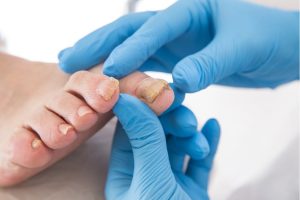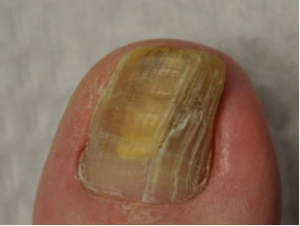A total nail avulsion (TNA) procedure involves the safe removal of the entire toenail. This procedure is indicated in a variety of circumstances, such as cases of ingrown toenails where both sides recurrently ingrow and there is a large curvature at the sides of the nail. Here, instead of removing two larger sides of the painful nail, a patient will opt to simply have the entire nail removed so it can grow back as a normal, straight nail – or not grow back at all depending on the method they choose.
Aside from ingrowing or involuting (high degree of curvature) nails, this procedure is also used as a solution for disfigured, thickened fungal, infected and damaged toenails where the nail itself is causing ongoing pain or great discomfort, especially when wearing shoes and performing daily activities.
This procedure may be performed with or without a chemical matrixectomy. When performed with a chemical matrixectomy, the nail will not regrow and you will no longer suffer from the problems your toenail was causing. When performed without, the nail will regrow from scratch, a process that takes approximately 12 months.
This may produce a new, healthy nail that does not cause the previous problems you were experiencing. For example, where fungal nail thickness was causing ongoing pain and discomfort and was very difficult to reduce, the new nail may grow to a normal thickness and no longer cause the original problems.
Because the growth of your new nail is determined by your body’s nail growing cells and not anything we can control, the nail may also grow back to continue to cause the same original problems. For example, where both sides of the nail were previously ingrowing, the nail may grow back in the same shape and the nail edges will continue to re-grow. This may be the case if the base of your nail has been exposed to injury or trauma, as it may have damaged the nail growing cells and resulted in the abnormal production of nail, resulting in a disfigured nail shape.
Don’t worry, we’ll assess your feet, nails and history of trauma to give the best advice on the best course of treatment for you and the results we’d expect to see. Once you have all of the information, you will be best informed on which procedure will be the best option for you.
The benefits of a TNA include:
- The procedure is done simply in-clinic
- The total appointment time typically doesn’t exceed 60 minutes (with the procedure time typically around 20 minutes)
- The procedure is performed under local anaesthetic so is pain-free
- You do not need to take any additional time off work/school following the procedure and can go home immediately
- You do not need any special boots or braces while the toe heals
- The procedure causes little post-procedure discomfort, however painkillers can be taken should discomfort arise
- We dress your toe. A take-home dressing pack can be purchased at our clinic. We will provide the re-dressing instructions.
- We monitor your progress to ensure it is healing well
The Procedure
This procedure is very similar to the PNA, but instead removes the entire nail.
- We first inject the toe with a common local anaesthetic using the thinnest needle possible for your comfort
- When the area is numb, we will perform the procedure in which the nail will be detached and pulled out
- If you already have an infection, it will be surgically drained and any overgrown tissue is cut away
- Where a chemical matrixectomyis part of the procedure, we apply the chemical (phenol) to the exposed nail base (where the nail growing cells are located), before flushing it away and neutralising the area
- We dress the toe with a number of dressing materials for optimal healing
Recovery time is anywhere from two weeks to two months barring any complications such as infection. We provide you with all the dressings, topical antibacterial solutions and ointments, the post-op shoe and aftercare instructions, all tailored individually to your needs.
Unsure which procedure is best for you?
Don’t worry – that’s exactly why we’re here. Because ingrown toenails can start from something as simple as your footwear choice for one day, they are unfortunately very common. This is our area of expertise and we see a variety of ingrown toenails every day, from full-blown infected swollen toes to small ingrown nails that don’t appear “bad” but are still quite painful and will only worsen as the nail continues to grow.
We start each appointment by assessing the toenail and discussing the likely cause of the problem. We’ll then be able to go through each procedure and their outcomes, and give you all the information you need to help you make the best choice and get the best results for your feet. After you leave your appointment, if you have any questions, our team is available to speak to during business hours and can also reply by email. We always put your health and well-being first and are here to help you in any way we can.
Recovery
Recovery time is anywhere from two weeks to two months barring any complications such as infection. We provide the post-op shoe and aftercare instructions, all tailored individually to your needs. You should keep your foot elevated for a few hours and rest on the day of the surgery; the next day, you can return to work or school. You should refrain from running or vigorous exercise for 2 weeks after the surgery. For most people, the wound will heal within several weeks. The pain will steadily lessen in the days following surgery and should have gone by the time the wound heals.
A person can help speed their recovery after the toenail surgery by:
- soaking the foot in warm water or Epsom salts every day
- taking ibuprofen (brand names: Advil, Motrin, Nuprin), to help with pain and swelling
- keeping the wound clean and dry, except when showering or cleaning the area
- keeping the wound bandaged until it heals, which usually takes several weeks
- avoiding strenuous activity that puts pressure on the nail
- wearing properly fitted shoes that are not too tight
- avoiding picking at the wound
Thickened fungal nail – before surgery
Thickened fungal nail – before surgery




